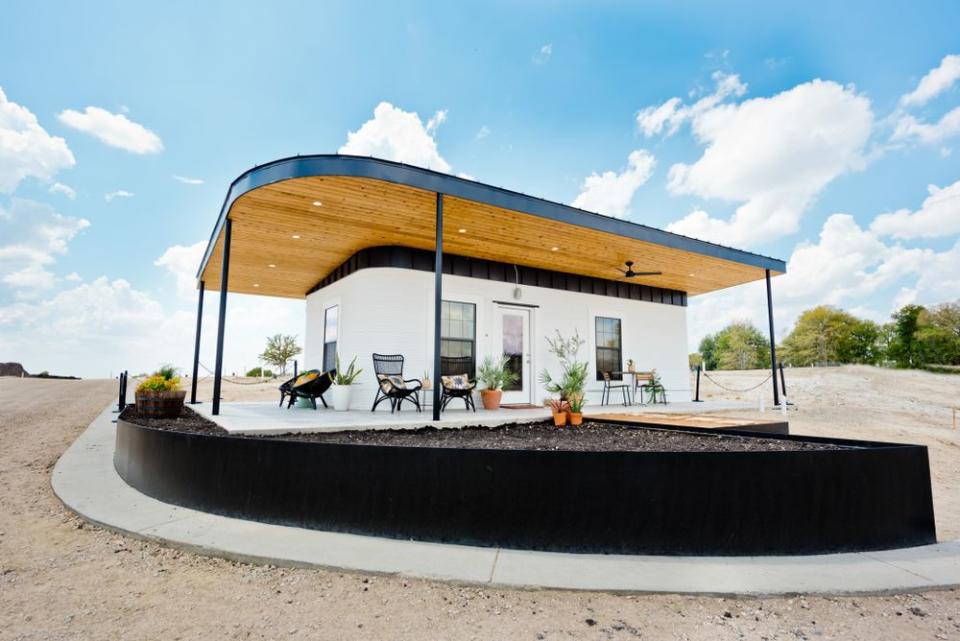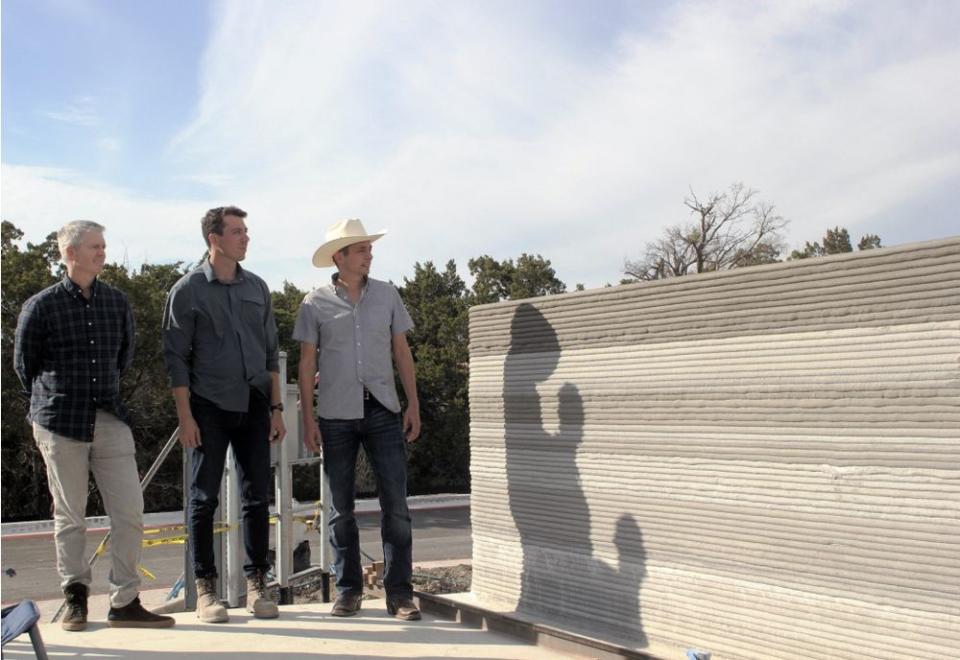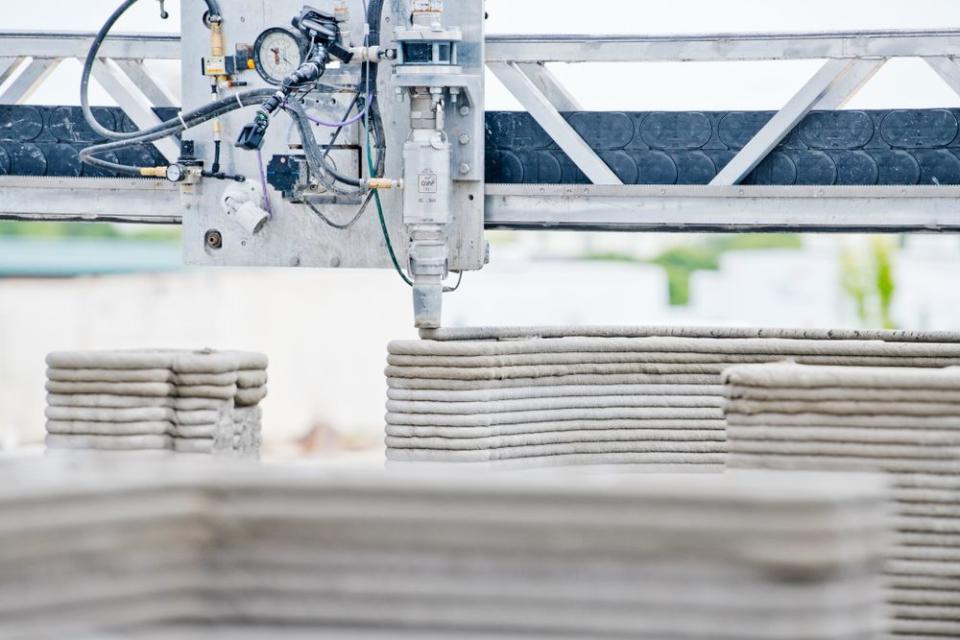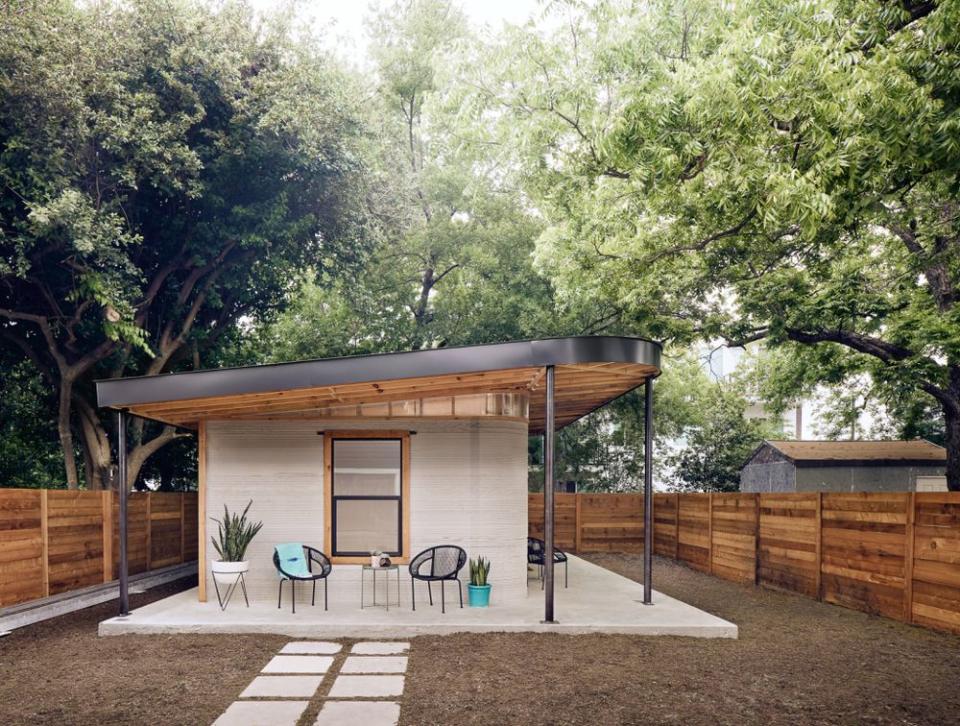These 3-D Printed Homes Cost Thousands Less and Are Being Built for the Homeless in Texas
Tim Shea, 69, has lived many places: a sidewalk, a shed, and a trailer, to name a few. Once in charge of the recycling program at AT&T Conference Center, chronic arthritis led him to leave the workforce at age 62, and he soon found himself homeless. Three years ago he moved into an RV with a ramp, so he could enter with his walker, at Community First! Village, a permanent housing community for formerly homeless people in Austin. Now, Shea is about to become the first person in the country to live in a 3D printed house, entrepreneur Jason Ballard tells PEOPLE.
“I am stoked,” says Shea, who happily wore a hardhat to tour his 400-square-foot concrete home that sits on the ground, alleviating the need for a ramp. He took in all the details as he walked through the common room, bedroom, bathroom and kitchenette.
“I love the ceiling, it’s got a real high ceiling,” he says. “It has an open plan, so if I end up in a wheelchair, everything’s wide open. It’s got these big windows, and a big back porch where I can take my laptop to write. All these politicians are trying to figure out what to do [with the homeless] — this is it.”
Shea’s home will be one of six printed houses in the Community First! Village neighborhood. The structures will have unique designs, including rounded walls, and take half the time to build as a conventional structure at a significantly lower cost.



The idea to print these homes was the brainchild of Ballard, 37. He had studied biology and was working in the construction industry, and what he saw so rankled him that he opened green building retail stores called TreeHouse. “Where are all the human and ecological health issues coming from?” he once asked himself.
“If you ask that question to a biologist or an ecologist, the surprising answer is buildings,” says Ballard. “Building is the No. 1 user of energy by sector, the No. 2 user of water, the No. 1 producer of landfill waste. It’s the No. 1 user of almost every resource category.”
“We have been building houses the same way for 1,000 years,” says Ballard. “If you took a picture of a house built in 1020 it would be sticks and nails and stones and bricks and mortar. It’s left us with certain irresolvable problems around affordability, speed, supply, sustainability, design — things that all of us value as human beings. As we get through the 20-teens and on to the 2020s, it’s like where is Rivendell [from the Lord of the Rings universe], where is Wakanda [Black Panther], where is The Jetsons? Where is this world we should have by now with advanced productivity and advanced technology delivering better solutions to make a better world?”
“The more you work in building you realize sustainability is not the only problem,” he says. “It’s impossible to live in a city like Austin without realizing the growing problems around homelessness and housing affordability. My hometown, Bridge City, Texas, on the Gulf Coast, has been destroyed by hurricanes and tropical storms four times in the last 16 years. My childhood home is gone, destroyed by a hurricane. They keep rebuilding my hometown with sticks and drywall and cellulose insulation. If I offered you $1 million to invent a less resilient material than sheetrock, you would not win a prize. I cannot believe we are still building with materials like that in places where we know there’s wildfires, we know there’s hurricanes, we know there’s tornados. It’s a tremendous human cost, it’s a tremendous cost to taxpayers, it’s a tremendous environmental cost. There has got to be a better way to build homes — it’s almost 2020.”
He began brainstorming with Evan Loomis, 39, a co-founder of TreeHouse, meeting monthly at a hotel bar. They considered every available technology — prefab, modular, shipping containers, ZIP panels — and stopped at 3D printing. “It was the only thing that we could find at the time that even offered the possibility of a breakthrough,” Ballard says. “We weren’t even sure it was possible, but we had to try.”

First they would have to build a huge printer that could print a house. As they worked nights and weekends in a warehouse, they learned about Alex Le Roux, now 27, who had founded a 3D printing company and was trying to build the same thing in Houston. Eventually they joined forces, formed a company, ICON, and built their printer, which they named Vulcan I. They earned a contract to build 50 affordable homes in Mexico, and completed the first permitted 3D printed house in the U.S. just 18 months ago in East Austin as a prototype. “That’s when the world got notice that this isn’t science fiction, this could be science-real,” Ballard says.
ICON has begun printing two homes at a time in Mexico, and three homes at a time in Austin with their latest aluminum-frame printers, dubbed Vulcan II. The printers are 33 feet wide and 11.5 feet tall, weighing 3,800 lbs., and can print at a speed of 5-7 linear inches per second. Each home takes 24 hours of print time for the basic structure, and more time is required for the installation of typical plumbing and electrical systems, windows, doors, roofs, cabinets, and fixtures.
Alan Graham, the visionary behind the community in Austin, says he was approached by builders touting dozens of alternative construction methods, and consistently rejected them. Recycled shipping containers — held up in the last few years as a panacea for affordable housing — treat people like cargo, he said. “In all of the models that have ever been presented, outside of conventional stick-built construction,” he says, “the 3D printed house was the one that mirrored our desire to meet the dignity of the human person.” He finds the printed houses architecturally appealing too. “They’re cute,” he adds.
RELATED VIDEO: PEOPLE’s 50 Companies That Care: See Our 2019 List of Employers Who Win by Giving Back
ICON’s goal is to build homes in twice the speed at half the cost of today’s conventional home, Ballard says. So far, they are down to half the time at 20 to 30 percent off the cost.
Ballard says the wall system is the typically the slowest, most expensive part of the construction process, involving 10 to 30 workers in a half dozen trades. Traditional construction crews build the structure, which usually entails framing, and move on to installing insulation and moisture barriers before finally applying interior and exterior finishes.
Meanwhile, printed homes require just three or four operators, one person working the printer and one working the machine that makes printable concrete on demand, plus assistants. By automating the construction of the wall system, the homes can go from groundbreaking to move-in-ready in three to four months. The builders are improving as they go, and they are currently experimenting with including cavities for mechanical, electrical and plumbing inside the printed walls so wires and pipes will not be exposed.
There are other benefits too. Their concrete mix offers a built-in moisture barrier, and is more resilient to mold, termites, mildew, wind and fire than typical building materials. Printing walls also creates a more thermally efficient building because it’s a continuous envelope. So far, Ballard says they have seen no structural cracking — the worry with concrete.

The ease of printing means that affordable housing doesn’t have to mean rows of identical cookie-cutter homes. A new design can be printed by changing the digital file, which doesn’t change the cost of the house — unlike many prefab or shipping container homes where one specific design has to be used to keep costs low. “If I printed 100 homes in a row they could all be radically different, and that’s what the customers want,” Ballard says. “Before it would be unthinkable to have those kinds of flourishes in more affordable housing.”
“With a 3D printer, slopes and curves are just as easy as a straight line,” he says. “You can introduce all kinds of exciting design options, more organic forms, things that we haven’t been able to imagine for a long time because they are usually only in very custom, high-end houses, reserved for the very, very wealthy, but with the 3D printers it’s no problem.”
Architect Andrew Logan, 37, designed all of ICON’s homes to date and says creating some of the world’s first 3D printed house designs “is every architecture student’s dream. It’s very exciting to be on the ground level.” He envisions 3D printing being useful in disaster relief because the process is quick. Typically an architect designs a house, generates a model, and prints it on paper, he says. Then a builder looks at the design, bids it, buys the materials and components, and assembles the building. 3D printing eliminates many of the steps. He also envisions a day when the same printer could switch materials after building the concrete structure and print other building components, including cabinets.

The houses are not yet available to the public. “We have chosen to start with people who need it most,” Ballard says. One day, though, he thinks it will be universal. “I think my kids will live in 3D-printed houses one day. I think this is going to become the preferred choice for building, at least residential buildings, because I can’t think of a faster, more affordable, more resilient way of constructing that offers more design freedom.”
Ballard says this is just the very beginning for printed homes. “It’s like a Wright brothers moment with the airplane. Think about how far airplanes came from that first few-hundred-yard flight on the beach. Now you can get a coffee at 30,000 feet and take a nap,” Ballard says. “There’s a lot of work still in front of us.”

